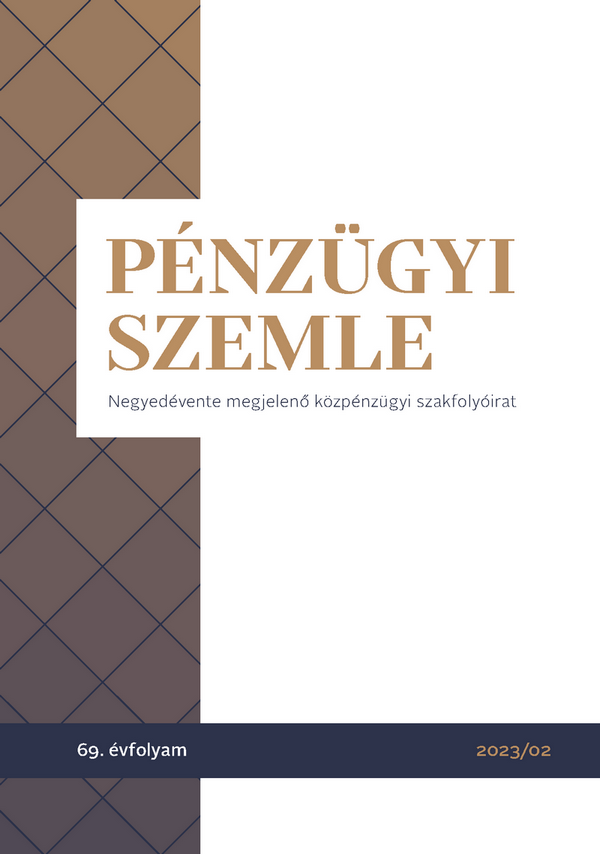Characteristics of splitting family tax benefit and strategies of those choosing the splitting
DOI:
https://doi.org/10.35551/PFQ_2023_2_1Keywords:
personal tax system, splitting of family tax benefit, sharing within the households, H24, H31, D13, D90Abstract
The study examines data regarding splitting of family tax benefit received upon children in personal income taxation and the strategies of those splitting the tax benefit. The purpose of the investigation is to analyse proportions of sharing and principles of couples who split the family tax benefit each other, increasing or decreasing each other’s financial opportunities. During the investigations, starting from a general analysis of the thousand people sample of family tax benefit beneficiaries from personal income tax return, we examined more detailed data of those who fully realized the family tax benefit. In the course of the examination we set up theoretical strategies for the analysis of the possible ways of splitting the tax benefit in order to check their matching with real data. The sharing strategy identifiable in the highest proportion was realizing the family tax benefit by 50%-50% by family members, which is influenced primarily by the realizing preferences of families with two children. A theoretical decision-making strategy has been identified in the case of more than half of the families fully realising family tax benefit. It has been found that, after the use in a fifty-fifty ratio, the preference of fathers’ recourse is slightly stronger than mothers’ due to the impact of families with three or more children. This is also typical of cases not identified with a specific strategy. The reason of preferring fathers’ recourse is mostly the idea that who has a larger tax base should use the tax benefit. However, this is not typical for giving preference to maternal use. Our findings indicate that families most often decide on the simplest solution that still can be considered rational, when sharing family tax benefit, which decision is differentiated according to the number of children.
References
Adema, W. (2012). Setting the scene: The mix of family policy objectives and packages across the OECD. (Megfelelő környezet megteremtése: családpolitikai célok és csomagok az OECD-országokban), Children and Youth Services Review, 34(3), pp 487-498. https://doi.org/10.1016/j.childyouth.2011.10.007
Banyár, J., Németh, Gy. (ed.) (2020). Nyugdíj és gyermekvállalás 2.0. Nyugdíjreform elképzelések. Konferenciakötet. Gondolat Kiadó, Budapest, 2020.
Botos, K. (2019). Beszámoló a Nyugdíj és gyermek 2.0 konferenciáról. Hitelintézeti Szemle, 18(3), pp. 158-163.
Borbély, Sz. (2011). A nemek egyenlőségének érvényesülése a magyar adó- és társadalombiztosítási rendszerekben, a foglalkoztatáspolitikában és hatásuk a nők foglalkoztatására. In: Nagy, I., Pongrácz T. (ed): Szerepváltozások. Jelentés a nők és férfiak helyzetéről 2011. TÁRKI - Nemzeti Erőforrás Minisztérium, Budapest, 2011, pp. 132-155.
Garfinkel, I., Sariscsany, L., Ananat, E., Collyer, S. M., Hartley, R. P., Wang, B., Wimer, C. (2022). The Benefits and Costs of a U.S. Child Allowance. NBER Working Paper Series, Working Paper 29854, National Bureau of Economic Research, March 2022. https://doi.org/10.3386/w29854
Gábos, A. (2005). A magyar családtámogatási rendszer termékenységi hatásai. Doktori értekezés. Budapesti Corvinus Egyetem, Szociológia és Szociálpolitika Tanszék, 2005.
Gábos, A., Tóth, I. Gy. (2000). A gyermekvállalás támogatásának gazdasági motívumai és hatásai. Századvég, 2000/4. pp 77-114. http://www.c3.hu/scripta/szazadveg/19/gabtort.htm#fn0
Giday, A. (2012). Életciklus-szemlélet és a társadalombiztosítás bevételei. Polgári Szemle. 8(3‑6), pp. 165–181.
Grow, A., Van Bavel, J. (2020). The Gender Cliff in the Relative Contribution to the Household Income: Insights from Modelling Marriage Markets in 27 European Countries. Eur J Population 36, pp. 711–733 (2020). https://doi.org/10.1007/s10680-019-09547-8
Klesment, M., Van Bavel, J. (2022). Women’s Relative Resources and Couples’ Gender Balance in Financial Decision-Making. European Sociological Review, 38(5), October 2022, pp. 739–753. https://doi.org/10.1093/esr/jcac019
Lentner, Cs., Horbulák, Zs. (2021). A gyermekvállalási és családtámogatási rendszer egyes állampénzügyi szegmensei Szlovákiában. Pénzügyi Szemle 66(4), pp 494-512. https://doi.org/10.35551/PSZ_2021_4_2
Mihályi P. (2019). A gyermekvállalás határhasznai és határköltségei. Pénzügyi Szemle, 64(4), pp 554-569. https://doi.org/10.35551/PSZ_2019_4_5
Pepin, J. R., Cohen, P. N. (2021). Nation-Level Gender Inequality and Couples’ Income Arrangements. J Fam Econ Issues, 2021 Mar 42(1), pp 13-28. https://doi.org/10.1007/s10834-020-09717-5
Sági, J. – Tatay, T. – Lentner, Cs. – Neumanné Virág, I. (2017). A család- és otthonteremtési adókedvezmények, illetve támogatások egyes hatásai. Pénzügyi Szemle, 62(2), pp 173-189.
Slotwinski, M., Roth, A. (2020). Gender Norms and Income Misreporting within Households. ZEW - Centre for European Economic Research Discussion Paper, 20-001. http://dx.doi.org/10.2139/ssrn.3527342
Downloads
Published
How to Cite
Issue
Section
License
Authors assign copyright to Pénzügyi Szemle / Public Finance Quarterly. Authors are responsible for permission to reproduce copyright material from other sources.












